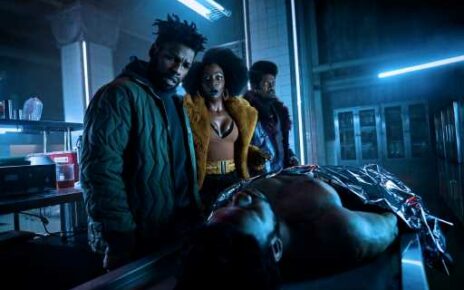Where the Crawdads Sing came out of nowhere four years ago to become one of the best-selling literary sensations of all time. Written by the hitherto little-known Delia Owens, who was 69 when the book was published in 2018, the novel about a little Southern swamp rat who had to contend with a fractured family, frightful destitution and an eventual trial for first-degree murder developed into a bestseller of astonishing proportions, topping the list for 32 weeks and spending 135 weeks on the list all-told.

Naturally, it became a hot property for the movies and ended up being produced by none other than that she’s-everywhere phenomenon named Reese Witherspoon, a southerner who might well have played the leading role herself had the book been around a quarter century ago. Unfortunately, this ripe-for-adaptation melodrama has been flattened, de-juiced and otherwise withered into a massively banal and flavorless porridge in which the two male leads, in particular, look as though they just stepped out of an L.L. Bean catalogue. What’s more, the central actress doesn’t even attempt a Southern accent; everyone else has one, so why not her? Perhaps the book’s fans won’t care, but by any objective standard this big-screen adaptation doesn’t cut it from all sorts of angles.
If you were to come across this film on its own without any prior knowledge of, or connection to, a renowned book, you’d likely pay it little, if any, notice; as a stand-alone movie with no stars or critical notoriety, it doesn’t have much to offer. But this is a different kettle of sea creature, the story of a woefully neglected little sprite who admirably perseveres and steels herself with precious little outside help to become a success on her own terms.
The film does little to explain how she manages this. One by one, those close to her disappear, and the only people who behave nicely to this “marsh girl” are a Black couple who run the local general store and help her out when they can. She’s an outcast and it’s amazing that she survives, but she does and, along the way, becomes a self-taught, highly idiosyncratic artist in the bargain.
From any angle, the odds are terribly against her, but she perseveres in ways that are barely shown and just have to be taken on faith. It would have been interesting to see how she learns and charts a path for herself artistically, but the details of her resourcefulness and budding creativity and are mostly skirted and the film never gets inside her head to make the viewer privy to how she learns to cope and, ultimately, excel.
Beginning in the early 1950s, the yarn is one of destitution, loss and little reason for hope; this swampy part of North Carolina is a place that offers precious few possibilities and seems to turn out very angry people. By the time she reaches her teens, Kya (British actress Daisy Edgar-Jones, of the limited series Normal People), most of her family has taken off. But instead of looking elsewhere, Kya stays put, eking out a solitary existence on a far fringe of society and eventually showing creative tendencies that will blossom in interesting ways.
By the early 1960s, three men come to play decisive roles in her life. Tate (Taylor John Smith) is a nice cute fellow who eventually heads off for college; Chase (Harris Dickinson) is a hunky bad boy who fancies himself the rooster in these parts, does Kya wrong and soon comes to no good; and Tom Milton (David Strathairn), a down-home lawyer who steps up to defend Kya when she’s wrongly accused of Chase’s murder. It all gets very sticky, and in melodramatic ways that have obviously grabbed the reading public’s appetite with its mixture of the sordid and the inspiring.
But it doesn’t come off well onscreen. For a dark and dirty yarn littered with bad behavior and base motives, the tenor of the proceedings is far too pretty and genteel; there’s little sense of the community in general, of peoples mixed motives and hypocritical attitudes. Nor is there a strong sense of Southern culture the way there was in, say, Elia Kazan’s late 1950s films such as Baby Doll, A Face in the Crowd or Wild River.
More significantly, the viewer is never really made to understand how, all by herself, Kya manages the transition from swamp girl to meticulous artist. Kya is onscreen much of the time but you never get inside her head, either when dealing with others or figuring out how she intends to carve out a life for herself alone and far from civilization. When she finally is forced to appear in such a formal setting as a courthouse for her murder trial, you wonder how she can cope with it all, but at least in this climactic stretch there is the compensation of Strathairn’s company as the defense lawyer who quietly and most competently handles his young client’s case.
Stylistically, the film, which was written by Lucy Alibar, who co-wrote the estimable Beasts of the Southern Wild, and directed by Olivia Newman, whose wrestling drama First Match appeared in 2018, could not be more conventional, emotionally or psychologically. When you finally see Kya’s life work in full flower, it’s quite impressive, but up to then there’s been no sign of her creative progression, of how she arrived at such an exalted state—suddenly, it’s just there. This is a rough story of abuse and survival, but it’s all treated in a surface way that just doesn’t penetrate, offer any insights or go deep.
Sony Pictures releases Where the Crawdads Sing on Friday.
Must Read Stories
Reactions, Historic Firsts, Wins By Program & Network, Ineligible Shows & More: Full Coverage

Emmy Snubs: ‘Yellowstone’, ‘Reservation Dogs’, ‘This Is Us’, Selena Gomez & More

Few Surprises From Noms, Glut Of Actors From Same Shows & Time To Overhaul TV Movie Category

Bombshell: Donald Trump Tried To Contact Committee Witness Last Week, Liz Cheney Says

Read More About:
Source: Read Full Article

